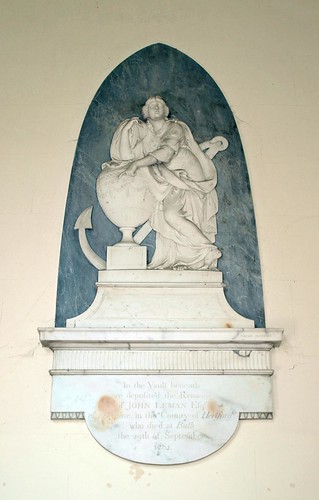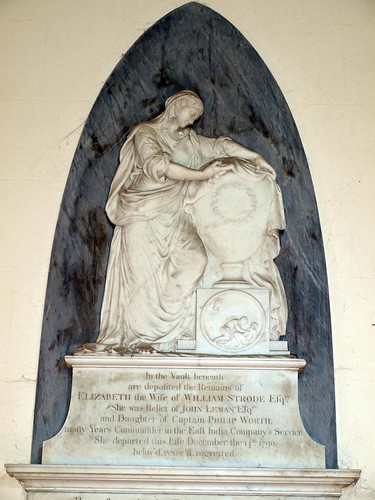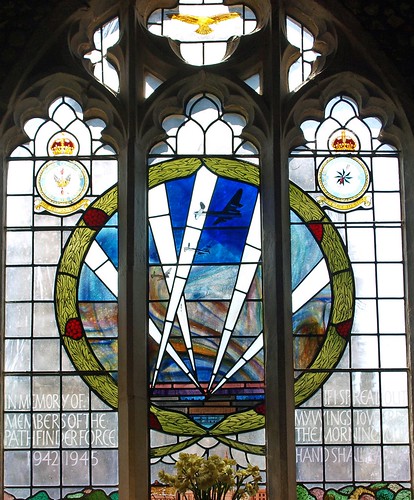ST MARY MAGDALENE. A stately church of brown cobble, but how could they, in 1832, rebuild the chancel in yellow brick, even if they chose lancets to match the superb C13 W steeple - C13 to the top of the broach spire? The tower is high and has broad flat buttresses with shallow set-ofis, a lancet window, once it seems not divided across but of its whole astounding length in one. The next stage has a cusped W lancet, shafted. Then the bell-openings, pairs of the lights each with Y-tracery with a foiled spandrel and much shafting. The lowest of the three tiers of lucarnes is in exactly the same style. The broaches are quite low. After this most impressive piece one must look at the oldest piece: the Norman chancel arch, with scalloped capitals to the triple responds, a tiny tree motif on one of the capitals, and an arch with two rolls and zigzag. Then, still chronologically before the tower, both arcades. They are of four bays and quite different one from the other; yet both date from the early C13. N has round and octagonal piers and arches with one chamfer and one more complex moulding including keeling, S has round piers, round capitals, and round abaci and double-chamfered arches, i.e. a more conventional parti. Very good bases. Then, to continue chronologically, the tower. What has not yet been said is that the arch to the nave goes with all the rest, and so do the lower N and S arches. So embracing aisles were provided for, although they (see the E arches) and most of the fenestration of the church are Perp. Nice N doorway of c.1300. - FONT. The font was obtained at the time when the enlargement by aisles took place. It is of table-top form and has stiff-leaf of the mature kind to the N. All the other sides are re-cut out of recognition. - DOOR KNOCKER. Chancel N. A small C12 piece with a lion’s head, and the ring made into two dragons fighting. - PLATE. Set of 1841-2. - MONUMENTS. John Leman d.1781. By Bacon. Hope pointing to an urn. - Mrs Strode d. 1790. Also by Bacon. Mourning woman by an urn. On the pedestal a fine small relief of the Good Samaritan.
WARBOYS. It has a delightful 17th century manor house with a most unusual east front, an inn in the High Street from the same century, and a church which was here centuries before either. We found two lions here, one at the church door and one hiding behind the organ. The lion at the door is the finest little thing that Warboys has; it reminds us of the famous knocker at Durham Cathedral. It is one of the best pieces of metal work in the country, showing the lion’s head biting a ring like two fighting dragons, and it was made by a man who must have found himself working with Norman masons. The other lion is carved on a stone bracket and is 15th century. Another notable carving is in the hood over the rectory door; it is 18th century. Very impressive are the handsome arcades of this clerestoried church, its tower and spire of great beauty. The spire springs from the edge of a low corbel table above eight belfry windows, and three rows of dormer windows rise high above anything else in Warboys. Men who remembered the signing of Magna Carta would look up at this spire with its little windows, so old is beauty here.
The pride of the village .for over 700 years, the church has a lovely Norman chancel arch with three shafts at either side and much fine ornament. The font is 700 years old, with flowers and leaves on its bowl, looking little worse for its long years of service. There is a stone coffin carved with rosettes in the 14th century.
Warboys remembers a sad story of the days of witchcraft. Here at the end of the 16th century a whole family was put to death: Mother Samuel over 80, her husband, and their only child. They were convicted on the evidence of the five daughters of their next-door neighbour, one of whom developed fits and imagined Mother Samuel to be responsible. Poor Mother Samuel was persecuted for two years, and in the end her family paid the bitter price of superstition.
It transpired at the trial that Alice Samuel, visiting the sick child, sat down in the chimney corner with a black cap on her head, and the child, pointing to her, cried, “Grandmother, look where the old witch sitteth.” The child became worse, and the doctor declared that he verily believed there had been witchcraft at work. The child’s sisters were afterwards seized, and all complained of “Mother Samuel.” Her repute as a witch grew. One of the children growing worse, the father entreated Mother Samuel to charge the spirit to leave her, and after much protestation she said, “I charge thee, spirit, in the name of God, that Mistress Jane never have this fit.”
The charge was repeated for all the rest, and the story at the trial was that immediately the children, who had been in the fits for three weeks, “wiped their eyes and stood up.” The poor woman, startled out of her wits, and imagining herself responsible, begged forgiveness. She was thrown into gaol, and in the course of time was interviewed by Lady Cromwell (wife of the Golden Knight of Hinchingbrooke) who now also became ill and died. In the end the three Samuels (father, mother, and daughter) were found guilty and executed. If windows can see and walls can hear this church at Warboys has seen and known it all.
The pride of the village .for over 700 years, the church has a lovely Norman chancel arch with three shafts at either side and much fine ornament. The font is 700 years old, with flowers and leaves on its bowl, looking little worse for its long years of service. There is a stone coffin carved with rosettes in the 14th century.
Warboys remembers a sad story of the days of witchcraft. Here at the end of the 16th century a whole family was put to death: Mother Samuel over 80, her husband, and their only child. They were convicted on the evidence of the five daughters of their next-door neighbour, one of whom developed fits and imagined Mother Samuel to be responsible. Poor Mother Samuel was persecuted for two years, and in the end her family paid the bitter price of superstition.
It transpired at the trial that Alice Samuel, visiting the sick child, sat down in the chimney corner with a black cap on her head, and the child, pointing to her, cried, “Grandmother, look where the old witch sitteth.” The child became worse, and the doctor declared that he verily believed there had been witchcraft at work. The child’s sisters were afterwards seized, and all complained of “Mother Samuel.” Her repute as a witch grew. One of the children growing worse, the father entreated Mother Samuel to charge the spirit to leave her, and after much protestation she said, “I charge thee, spirit, in the name of God, that Mistress Jane never have this fit.”
The charge was repeated for all the rest, and the story at the trial was that immediately the children, who had been in the fits for three weeks, “wiped their eyes and stood up.” The poor woman, startled out of her wits, and imagining herself responsible, begged forgiveness. She was thrown into gaol, and in the course of time was interviewed by Lady Cromwell (wife of the Golden Knight of Hinchingbrooke) who now also became ill and died. In the end the three Samuels (father, mother, and daughter) were found guilty and executed. If windows can see and walls can hear this church at Warboys has seen and known it all.



No comments:
Post a Comment